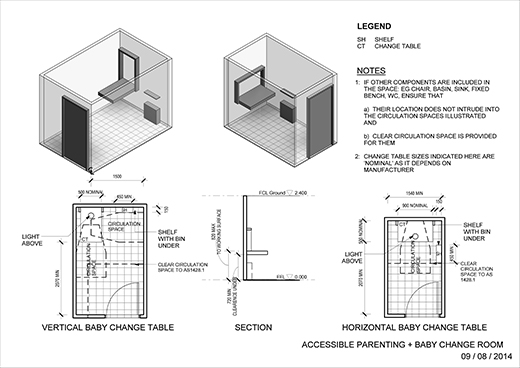The access provisions of Premises Standards 2010 have been incorporated into NCC Volume 1 BCA, effective from 1 May 2011.
In all public buildings, access is required to and within all areas normally used by the occupants. Fit-out criteria for these spaces are not included in the BCA. Uninformed design of fit-out can render a space inaccessible, despite its compliance with the BCA access provisions . Inaccessible buildings and spaces are at risk to complaint under the DDAct.
Accessible parenting / baby change room
1. APPLICATION
Accessible Parenting and Baby Change Rooms are required in Early Childhood Centres in some jurisdictions and should be provided at other premises such as:
- major transport facilities, eg airports, train stations, bus terminals and shipping ports
- stadia
- offices accommodating public services, eg government departments, Medicare and Centrelink
- large professional and business offices
- medical and paramedical facilities, including hospitals, clinics, and consulting rooms
- public outdoor spaces and facilities
2. DESIGN CONSIDERATIONS
This Design Guide contains criteria for elements which are beyond the scope of the NCC and the Premises Standards. As far as possible it does not repeat the mandatory requirements of the NCC.
Circulation
The illustration shows circulation spaces for the change table and allows room for a perambulator. If other components are included in the space, eg chair, basin, sink, fixed bench or WC, ensure that:
(a) their location does not intrude into the circulation spaces illustrated; and
(b) clear circulation space is provided for them to meet AS1428.1
Provide clear circulation space at the long side of the change table, and in addition at the short side where a vertical table is used. These circulation areas may overlap other circulation areas within the space.
Door
Meet AS1428.1 including a minimum clear opening of 850mm and circulation clear of all fittings. If the door opens out, locate it to open clear of transverse traffic, for example by ensuring that the door opens out against a side wall.
Type and location of baby change table
Proprietary baby change tables measure about 900mm wide (horizontal model) and 500mm wide (vertical model).
Horizontal model is recommended for accessible facilities. If a vertical model is required due to spatial constraints, ensure that:
(a) the selected product has, or is provided with, a hand grip at an accessible height, i.e. not higher than 1100mm above floor level when installed in accordance with AS1428.1.
(b) the change table is mounted at not less than 425mm from its centreline to a side wall or any obstruction in order to provide wheelchair circulation space similar to AS1428.1 Figure 45.
Meet AS1428.1 clause 15.2.8.2 for location of baby change table, including maximum 820mm height of the leading edge and minimum 720mm knee-space clearance underneath when the table is in the open position.
Provide 100mm minimum clearance to any obstruction on both sides of table to ensure that hands do not get jammed when opening/closing the table.
Other features
Provide additional shelf space for changing materials minimum 150mm wide and 450mm long at a height level with the top of the change table and within reach of change table when down (ie maximum 300mm away and beside circulation space).
Provide glare-free lighting in the work area and above the change table of not less than 200 lux.
3. REFERENCE
AS1428.1 - 2009 (Incorporating amendment No.1 - 2010) Design for Access and Mobility Part 1: General Requirements for Access-New Building Work
4. DRAWINGS
Accessible Parenting and Baby Change Room.
Disclaimer
This content is provided by the Australian Institute of Architects for reference purposes and as general guidance. It does not take into account specific circumstances and should not be relied on in that way. It is not legal, financial, insurance, or other advice and you should seek independent verification or advice before relying on this content in circumstances where loss or damage may result. The Institute endeavours to publish content that is accurate at the time it is published, but does not accept responsibility for content that may or has become inaccurate over time. Using this website and content is subject to the Acumen User Licence.

